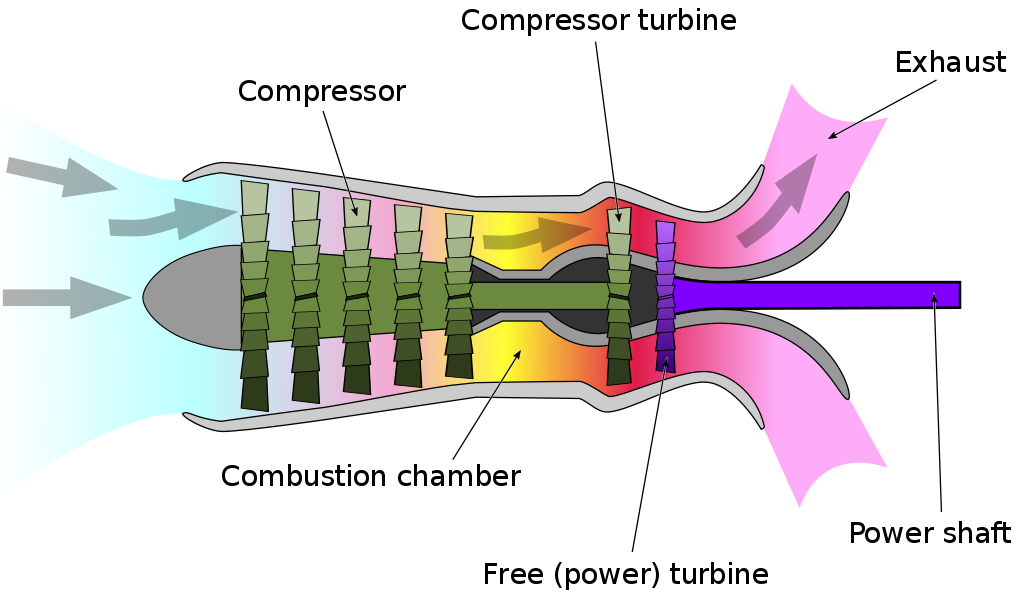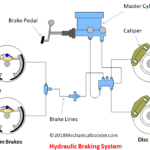Whether you are a mechanical engineering student or addicted to engineering, a jet engine is a topic that is liked by everyone. From our childhood, we have seen something fly in the sky just like birds. These bird-like flying objects either may be airplanes or fighter jet planes. Now a question pop-ups in our mind that how they fly in the sky. So It is the jet engine by which it gets possible. The engine is the heart of a vehicle and the same situation is applied to a jet engine. Inside this article, we are going to discuss how a jet engine works. So, without waiting too much let us get started.
What is Jet Engine?
A jet engine converts the liquid fuel into a strong force named as thrust. This force works for pushing the jet forward. Since this engine produces a strong jet of Exhaust gases at the exit that’s why this engine is called as jet engine For a better understanding of the jet engine, it is important to understand the working of the piston engine that is currently used inside the cars.
The History Behind Jet Engine:
Around 1800, George Cayley invented the steam engine. After that in 1884, Sir Charles Parsons’s invention did amazing work regarding the steam turbine and compressor.
Have you ever heard about the ramjet? You might have heard this word in your school while learning history. Ramjet is the simplest type of jet engine. Later in 1910, Sir Henry discovered the jet-like plane where he used a big fan instead of a propeller.
After several years, which means in 1936, Whittle invented the turbofan engine. For this invention, he also filed a patent. This engine discovered by him is also termed as “Whittle’s engine”.
In 2002, GE90-115B becomes the most powerful engine in the entire world. This engine was made by General Electric. In 2019, GENX is the most used engine in jet airplanes. This engine produces less thrust but works with high efficiency.
Action and Reaction:
The basic principle behind the working of the jet engine is Newton’s Third Law. As per this third law, every action has an equal and opposite reaction. Also, the principle of conservation of energy plays a crucial role in the working of the jet engine.
Main Parts of Jet Engine
Before understanding the working of the jet engine, now let us take a glance at the main components of the jet engine:

- Compressor: Inside the compressor, the pressure as well as the speed of the air increases. It is mainly used to compress the air from the atmosphere so that the burning of the fuel can be achieved with this highly compressed and high-temperature air. Now a question hits why air is compressed in the jet engine, so its answer is very simple because we all know that oxygen helps in burning. The more will be oxygen the more will be burning. And compressed air has a high density of oxygen.
- Combustion Chamber: Inside the combustion chamber, the burning of the air-fuel mixture takes place and it produces burnt gases and the temperature inside the engine increases.
- Turbine: The turbine in the jet engine is used to convert the energy of high-velocity exhaust gases into mechanical energy. This mechanical energy is used to drive the compressor. The turbine and compressor have a common shaft in between them.
- Nozzle: Nozzle does the work of increasing the speed of the exhaust gases coming out of the jet engine.
Also Read:
- Different Types of Engine
- What are the Main Parts of an Automobile Engine?
- What is Stirling Engine – Types, Main Parts, Working and Application?
Working of Jet Engine
Now, let us take a glance at how the jet engine works?
The working of a jet engine is quite simple. Below diagram shows you how the jet engine works:

- Considering the jet engine moving very slow as compared to the speed of the sound, the speed of the engine is considered to be around 600 mph. That means the speed of the engine is considered to be around 1000 km/h
- A fan is present at the front side of the engine. This fan takes the cold air into the engine and forces this air into the inlet. Due to this, the speed of the engine slows down to 605 of its initial speed.
- Now, the compressor present inside the engine squeezes this air. Due to squeezing, the pressure increases. This pressure rise is almost 8 times the initial pressure. Due to such high pressure, the temperature inside the engine increases to a high amount.
- After this kerosene is added inside the engine from the fuel tank.
- Inside the combustion chamber, Compressed air is mixed with the kerosene combustion takes place resulting in the formation of hot exhaust gases. Due to this temperature inside the combustion chamber increases. The general temperature of this mixture is considered to be 900ºC. In other words, this temperature is 1650º F
- The exhaust gases then pass through the turbine blades. These gases spin these blades like a windmill. As per the energy conservation, here one form of energy is converted into another. Turbine blades gain energy while exhaust gases lose energy by cooling down. This also results in a decrease in the pressure of exhaust gases.
- The blades of the turbine are connected to the axle which runs throughout the length of the engine. Both the compressor and the fan are also connected to the axle of the engine. That means after the rotation of the turbine blades, fan as well as compressor also get a turn.
- A nozzle is present at the other end of the engine. The exhaust gases exit the engine through the nozzle. The tapered nozzle helps the gases to exit the engine with a high speed of the 2100 km/hr
- Looking at this speed we can say that the speed of the gases leaving the engine is twice that of the speed of the gases entering the engine. This speed power the jet engine. All these gases move backward with high speed while the jet moves forward due to the thrust. Greater the thrust greater is the speed of the jet. The military jet has an additional burner for producing extra thrust. Here, thrust plays an important role. For the better speed of the engine, we have to focus more on producing more thrust.
For Better understanding How Jet Engine Works Watch the Video Given Below:
Types of Jet Engine:
All the types of jet engines work on the same basic process: taking the air in, compression, combustion, throwing exhaust gases outside the engine.
Though they follow the same basic process. Some of the engines have additional components. And the jet engine has the following types:
1. Turbojet Engine

It is an airbreathing type of jet engine in which jet engine is propelled by the jet of hot exhaust gases. The hot exhaust gases are formed by the atmospheric air entering into the engine is compressed and burnt into the combustion chamber. It mainly consists of a gas turbine and a propelling nozzle. And the components of the gas turbine is a compressor, combustion chamber and a turbine to drive the compressor. It is mostly used in aircraft and highly efficient for supersonic aircraft. It is not suitable for slow aircrafts.
2. Turbofan Engine

Turbofan engine is widely used in the aircraft Propulsion. It is an airbreathing type of jet engine. It is made from two words. The first word is Turbo that means the Turbine which produces mechanical energy from Combustion and the second word is Fan (Ducted fan) which accelerates the moving air towards the combustion chamber with the help of mechanical energy from the turbine. It is also called a turbojet engine with a big fan at the front of the engine. In a jet engine, all the air taken in is passed through the turbine but in the case of a turbofan engine, some of the air is bypassing the turbine.
Also Read:
- What is Gas Turbine Power Plant?
- What is Reciprocating Air Compressor?
- What is Reaction Turbine – Principle, Working, Main Components and Application
3. Turboprop Engine

All the components of the turboprop engine is same as the turbojet engine with an extra propeller fan at the front. If we see a turbofan engine in its simplest form then it consists of intake for air, a compressor for air compression, combustion chamber for air-fuel combustion, the turbine for obtained mechanical energy and a propelling nozzle. The air enters through the intake and the compressor compresses the air to a specified temperature and pressure. The compressed air then enters into the combustion chamber where fuel is mixed with the compressed air and the combustion of the air-fuel mixture takes place. The combustion generates hot exhaust gases that expand on the turbine blades and rotate the turbine. The mechanical energy obtained from the turbine is used to drive the propeller of the turboprops through a reduction gearbox (i.e it converts high rpm/low torque into low rpm/high torque.). The exhaust gases after the turbine leaves through the propelling nozzle and provide and extra thrust to the jet engine. Here the thrust provides by the propelling nozzle is quite less than the propeller at the front. In the turboprop engine, the propeller is the main source for the thrust generation and propelling nozzle gives an extra thrust.
4. Turboshaft Engine

When a gas turbine is optimized to produce shaft power instead of producing jet thrust, It is called a turboshaft engine. The working of the turboshaft engine is similar to the turbojet engine. It mainly consists of an air intake, compressor, combustion chamber, Turbine and a Free turbine with a power shaft. The free turbine produces the required shaft power that is used by other machines for their working.
The air enter into the turboshaft engine get compressed in the compressor and enters into the combustion chamber where the fuel mixed with the air and combustion happens. The exhaust gases produced drives the turbine as well as a free turbine. The turbine drives the compressor and the free turbine produces the shaft power which is utilized in some other work.
Turboshaft engines are used in the area where there is a requirement of high reliability, high power output, small size, and lightweight. They are mainly used in helicopters, boats and ships, tanks and stationary equipment.
5. Ramjets & Scramjet Engine

It is a type of jet engine which uses the forward motion of the engine for compressing the incoming air without any axial or centrifugal compressor. Sometimes it is called a flying Stovepipe. It can not produce thrust when the airspeed is zero. It means they cannot move an aircraft when it is standstill. So a vehicle which is powered with ramjet engine Requires an assisted take-off (an agency that helps the aircraft to get into air) to make it reach up to that acceleration where it can begin to produce thrust.
It works more efficiently when it reaches supersonic speeds that are around Mach 3 (2,300 mph, 3700 km/h). And the maximum speed upto which ramjet engine can be operated is around Mach 6 (4,600 mph, 7400 km/h) They are used in missiles, artillery shells. It is also called a Scramjet Engine.
Conclusion
In this way, we have discussed how jet engine works, its types as well as other details. I hope you have liked this piece of info. If you have any queries about this topic then, feel free to reach out to us.
Image Source: https://en.wikipedia.org








